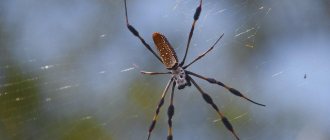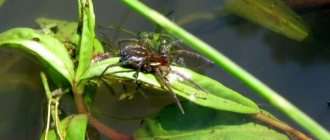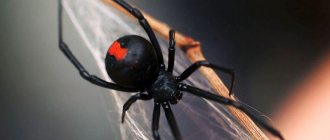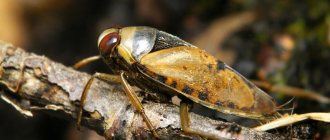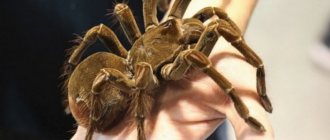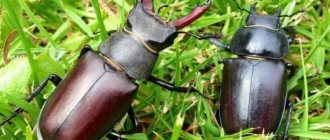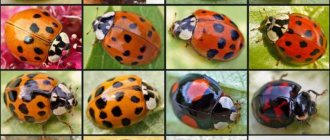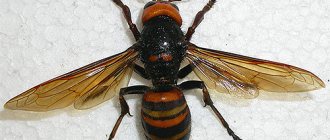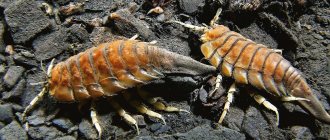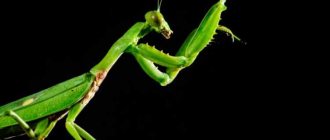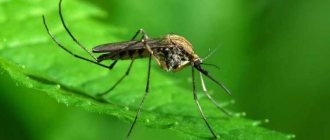Kirill Mikhailov, Candidate of Biological Sciences, Zoological Museum of Moscow State University. M. V. Lomonosova
Prokopiy Nogovitsyn,
Oysk secondary school named after.
A. V. Dmitrieva (Oy village, Khangalassky ulus, Republic of Sakha (Yakutia)) “Nature” No. 10, 2017
Female silver spider. Photo by J. Lissner (Denmark)
As befits predatory animals, the vast majority of spiders live alone, joining in pairs only for the breeding season. Colonial forms are known for literally a few dozen of the more than 45 thousand species described to date. Most colonial forms live in tropical countries. Coloniality manifests itself primarily in the cohabitation of large groups, which, as a rule, still eat separately. Combined hunting and feeding on prey is observed only in a few species; The most studied in this regard is the small spider Anelosimus eximius
(family Theridiidae), living in South America.
Two hypotheses have been put forward for the origin of coloniality in spiders. One of them involves the accumulation and cooperation of adult individuals around an abundant food resource, when there is enough food for everyone and there are no special reasons for showing aggression towards neighbors. According to the second hypothesis, the offspring of one female, growing up, do not disperse, but continue to live together. Perhaps both of these hypotheses apply to different species of colonial spiders.
Colonial spiders do not live in Russia and neighboring countries. But in the southern regions, accumulations of orb-weaving spiders (family Araneidae) on the coasts of water bodies have been repeatedly noted. They are most likely associated with the mass production of some small flying insects that these spiders feed on. On the coast of of Araneus pallasi described in Balkhash
[], and on the shores of the Caspian Sea, north of Krasnovodsk, -
Larinioides folium
[].
In the summer of 2012, in the city of Yeisk on the coast of the Sea of Azov, K. G. Mikhailov was able to observe a concentration of L. folium
on vegetation and walls of buildings located on the Yeisk Spit in close proximity to the sea.
This concentration was associated with the annual mass flight of the bell mosquito ( Chironomus plumosus
, family Chironomidae). The sanatorium staff barely had time to sweep away the cobwebs so as not to scare the vacationers...
Young silverfish, lake. Balaton. Photo by W. Pflieger (Germany)
However, there are spiders whose mass concentrations are difficult to imagine, especially on land. This is the silverback water spider ( Argyroneta aquatica
), the only spider whose entire life cycle takes place within a fresh body of water. Silverfish are an example of the secondary return of an arachnid to the aquatic environment, which is not very typical for representatives of this class. Of the other arachnids, only water mites, which are found in both fresh and salt waters, have switched to permanent residence in water. The silverfish is widespread in the Northern Hemisphere, in Russia and neighboring countries it is found everywhere, and has even been recorded in a few reservoirs in the desert zone of Central Asia. In some countries, silverfish are rare; for example, in Japan this species was included in the Red Book back in 1995. Let us briefly describe the biology of this wonderful spider [, ].
Description
The silverback spider is the only spider that has perfectly adapted to an aquatic lifestyle. The male is much larger than the female, reaching up to 15 mm in length, and the female - up to 12 mm. The body consists of a cephalothorax, abdomen, and four pairs of legs. The silverfish has 8 pairs of eyes and 2 pairs of jaws. The color of the insect varies from light brown to brown, almost black. The abdomen is lighter in color and covered with small hairs that capture air when the spider dives. In water, the spider’s abdomen looks silvery—hence the name “silver spider.”
Features of keeping at home
Sometimes this spider is kept as an exotic pet. Such a pet is interesting because it is active during the day (especially the male), and water spiders are entertaining to watch.
It is recommended to use an aquarium of about 5 liters per adult. To weave a bell, a water spider will need a base of branches or aquatic plants. Thanks to this, you can determine the place where the spider will build a nest. Some of the branches must come out of the water so that the silver spider has the opportunity to get out onto land.
You can feed the arachnid with small fish, gammarus, water donkeys and various insects. It is acceptable to keep females and males in the same aquarium, but it is important to consider that if the spiders do not have enough food, they will begin to show aggression towards each other. Also, juveniles should not be kept together with adults.
Nutrition and lifestyle
This spider lives in water all year round. Underwater it builds its nests, shaped like a bell, which it fills with air, carrying it on its abdomen. The nest is firmly attached to stones, plants or snags. The water spider leads a nocturnal predatory lifestyle. It feeds on insect larvae, fry of small fish and crustaceans, catching them with its underwater web or hunting for them on the surface of the water. The spider sometimes hangs the excess prey it catches in its nest. For the winter, silverfish occupy empty mollusk shells, which they carefully cover with cobwebs, or build their own cocoons.
Interestingly, young spiders can move to other bodies of water. To do this, they climb out of the water onto the plant and release threads, which, together with the spiders, are carried by the wind to new bodies of water. Having multiplied abundantly, silver spiders destroy the fry, reducing the number of beneficial fish. It should be remembered that a water spider bites a person quite rarely, by accident, usually for the purpose of self-defense. A bite causes redness, pain, burning, swelling, swelling on the body, and poor health. The condition returns to normal within a few days.
Why is a water spider dangerous for humans?
A water spider will not purposefully attack a person, but it can attack in case of danger. In most cases, the silver spider will try to escape; it extremely rarely shows aggression and bites a person. And if it lives in captivity, it reacts to the presence of people quite calmly.
Spider venom can cause an allergic reaction, especially in children, pregnant women and people with weak immune systems. The list of main symptoms of a bite includes: slight swelling, redness of the skin, burning.
Allergies include nausea, vomiting, dizziness, fever, weakness, and headache. Symptoms in most cases go away on their own after a few days, but despite this, it is recommended to take antihistamines.
The water spider can harm agricultural sectors such as fish farming. By eating fry, representatives of this species significantly reduce the number of fish. But, as a rule, weak fry become victims of the water spider, i.e., in essence, the spider plays the role of a natural breeder.
Life cycle
Females, unlike other spiders, are quite calm towards males. By the time of reproduction in the spring, the silverfish builds an egg cocoon in its bell house and lays from 15 to 160 eggs there. After about 10 days, young spiders emerge from the eggs; they are hairless and therefore cannot yet emerge from the bell and swim in the water. The cubs remain under the mother's supervision for about a week, and during this time the first two molts occur. And only after this the young spiders emerge from the bell and begin to lead an independent life. They grow quickly and, with plenty of food, reach their maximum size within three months. Although silver spiders overwinter in different stages, juveniles predominate, and therefore in spring shallow water bodies abound with young spiders. The lifespan of a water spider is about 18 months.
How does the silverback spider produce offspring?
This phase of the life cycle is again accompanied by the creation of a special cocoon. Its purpose: to be a refuge for spider eggs. In such a cocoon, woven from its own web, the female silverfish lays from 10 to 100 eggs.
The spider collects excess air into a cocoon.
The female very carefully and zealously protects her clutch from outside attacks. Babies that are born gain height and weight very quickly. When they are only two weeks old, they already leave their parents' home and begin to live independently.
Young individuals often move to live in another body of water, but there are also cases when they remain in their native pond or lake.
The silverfish overwinters in shells abandoned by snails.
Notes
- Annotated list of rare and endangered species of invertebrate animals, specially protected within Russia // 2003* Russia* Red List of Specially Protected Rare and Endangered Animals and Plants. (2nd issue). Part 2. Invertebrate animals (Red Book Bulletin, 2/2004 (2008)) / rep. ed. V. E. Prisyazhnyuk. - M.: Red Book Laboratory of the All-Russian Research Institute for Nature Conservation, 2004 (2008). - P. 118. - 512 p. — ISBN 978-5-9243-0158-7 [https://ashipunov.info/shipunov/school/books/krasnyj_spisok_rossii_2008_2_besp.pdf Full text]
- Lange A. B. Subtype Chelicerata // Animal Life. Volume 3. Arthropods: trilobites, chelicerates, trachea-breathers. Onychophora / edited by M. S. Gilyarov, F. N. Pravdin, ch. ed. V. E. Sokolov. — 2nd ed., revised. - M.: Education, 1984. - P. 68. - 463 p. — 300,000 copies.
- I. I. Akimushkin.
Patent for a diving bell // Insects. Spiders. Pets. — 4th ed. - M.: Mysl, 1995. - T. 3. - P. 219-220. - (Animal world). — 15,000 copies. — ISBN 5-244-00806-4. - Microcosmos (film, 1996), 40 minutes
Where does the Brazilian wandering spider live?
Photo: Dangerous Brazilian wandering spider
The main habitat of this species is America. Moreover, most often these arthropods are found in the tropical forests of Central and South America. Representatives of this species can also be found in Brazil and northern Argentina, Venezuela, Peru and Havana.
Spiders are thermophilic; the main habitat of these arthropods is the tropics and jungle. There they are placed on the crowns of trees. Spiders do not build shelters or burrows for themselves; they constantly move from one habitat to another in search of food.
In Brazil, spiders of this species live everywhere, perhaps only in the northern part of the country. Both in Brazil and in America, spiders can crawl into houses, which terribly scare the local population.
They love warm and humid tropical climates. Spiders of this species do not live in Russia due to the climate. However, they can be found accidentally brought from warm countries in boxes with tropical fruits, or by spider lovers for breeding them in a terrarium.
In recent years, this dangerous animal is increasingly being kept at home as pets. At home, they can live all over the world, but keeping them is not recommended due to the extreme danger of this species. Spiders also don’t live well in captivity, so you need to think carefully before getting such a pet.
Now you know where the Brazilian wandering spider lives. Let's see what he eats.
Population and species status
Photo: Water spider
Water spiders inhabit vast areas of Eurasia, and they can be found in almost every body of water, often in quite large quantities. As a result, this species is considered one of the least endangered species - so far it clearly does not have any problems with the population size, although calculations are not being carried out.
Of course, the deterioration of the environment in many reservoirs could not but affect all the living creatures living in them, however, silverfish suffer the least from this. To a lesser extent, but this can also be attributed to their prey, due to the disappearance of which they could also be forced to leave their habitats - various small insects, they are also not so easy to remove.
Thus, we can conclude that of all highly organized living organisms, extinction threatens the majority of spiders, including silver spiders, perhaps least of all - these are well-adapted creatures capable of surviving even in extreme conditions.
Moreover, they are unpretentious: they only need to be fed and the water changed from time to time. It is also necessary to close the container with them, otherwise the spider will sooner or later go on a journey through your house in search of a new habitat, and maybe, what the hell, fly out into the street or be accidentally crushed.
The water spider, even though it is poisonous, is a harmless creature for people if not touched. It is unique in that it weaves its nets right in the water and constantly lives and hunts in it, even though it does not have a breathing apparatus adapted for underwater life. It is also interesting because it can equip empty shells for hibernation.
Tags:
- Argyroneta
- Argyroneta Latreille
- Dictynoidea
- Entelegynae
- Neocribellatae
- Opisthothelae
- Panarthropoda
- Araneomorph spiders
- Bilaterally symmetrical
- Animals of Belarus
- Animals of reservoirs
- Animals of Eurasia
- Animals of Europe
- Animals of Kazakhstan
- Animals starting with the letter B
- Animals starting with the letter P
- Lake animals
- Animals of the rivers
- Animals of Russia
- Animals of Ukraine
- Animals of the Temperate Zone of the Northern Hemisphere
- Shedding
- Dangerous spiders
- Dangerous spiders in Russia
- Spiders
- Spiders of Russia
- Cybeid spiders
- Protostomes
- The most disgusting spiders
- Scary spiders
- Cheliceraceae
- Arthropods
- Eukaryotes
- Eumetazoans
- Poisonous spiders
- Poisonous spiders in Russia
Class Arachnida
- Integument, musculoskeletal system
- Digestive system
- Respiratory system
- Circulatory system
- Excretory system
- Nervous system
- Reproductive system
The body is divided into the cephalothorax and abdomen, covered with a chitinous cuticle, which serves to protect the animal from drying out. The body cavity is a mixocoel. The abdominal limbs are absent (reduced); there are a total of six pairs of jointed limbs. Two of them, closest to the head end of the body, are transformed into chelicerae.
Chelicerae (from the Greek chele - claw claw and keras - horn) are the first pair of head, usually claw-like limbs in arthropods of the chelicerate subtype. Their main function is to grab and tear prey, grind and crush food. The chelicerae consist of 2-3 segments and often end in a claw.
Behind the chelicerae there are leg tentacles - pedipalps (from the Latin pes (pedis) - leg and palpus - tentacle). The pedipalps are the second pair of articulated limbs on the cephalothorax in arachnids. They serve for grasping and chewing food, as well as for the sense of touch. The bristles on the pedipalps prevent solid food from entering the mouth - remember that spiders feed on liquid food and have special digestion. Soon you will know everything 
On the lower abdomen of the spider there are special organs - arachnoid warts (modified abdominal legs). These are paired articulated outgrowths (from one to four pairs), the main function of which is the formation of arachnoid fiber. With the help of arachnoid fibers, spiders build a trapping network, which we call a cobweb (net).
Each spider's web has its own unique pattern; it consists of dry and sticky threads. The spider builds its own web and knows very well which threads are sticky and avoids them. Other animals do not know this secret and therefore get confused easily.
The spider has eight walking legs (four pairs). All representatives of the chelicerate subtype, including the cross spider, are characterized by the absence of antennae: they have neither antennules nor antennae.
Remember that spider digestion is extraintestinal. Having caught prey, the spider inserts chelicerae into its body and injects poison (formed in the poisonous glands). The victim is enclosed in a cocoon of web, after which the spider injects the secretion of the salivary glands into the victim, which begins to literally digest the victim outside the intestines of the spider - hence the name! After some time, the spider can simply suck in the already digested organs and tissues of the victim. The spider does not eat solid food.
The digestive system of arachnids consists of the foregut, midgut and hindgut. The foregut consists of a pharynx, a crop and a sucking stomach, which is equipped with powerful muscles and acts like a rubber bulb. Thanks to its sucking stomach, the spider pulls out the digested organs and tissues of the victim.
The midgut, whose main function is absorption, has numerous blindly ending projections that increase the total area of absorption. The hindgut ends with the anus, through which undigested food remains are expelled.
In addition to a pair of lung sacs, the spider has a tracheal system. The spider's lung sacs are modified skin outgrowths and have the shape of parallel partitions.
Tracheas are the respiratory tubes of arachnids and insects, opening on the surface of the body with special openings - stigmas (spiracles), most often lying in pairs. The inner wall of the trachea is represented by a chitinous membrane, which protects the trachea from collapse.
Thanks to the tracheal system, oxygen is delivered to the tissues and organs of the spider, and carbon dioxide is removed from the body.
The circulatory system of the spider, like all arthropods, is not closed (lacunar type). It consists of a tube-shaped heart, the functioning of which occurs in the same way as in crustaceans. The heart lies in the pericardial sac. From the heart there is an aorta, several arteries and a system of lacunae in which hemolymph circulates, washing the internal organs and tissues.
It should be noted that the developed tracheal system greatly simplifies the structure of the circulatory system, which practically does not participate in the transfer of oxygen. It is for this reason that there are no capillaries and small vessels in the circulatory system.
Thus, the main function of the circulatory system becomes the transport of nutrients to the cells and tissues of the body.
The excretory organs are the Malpighian vessels. Malpighian vessels are thin (thread-like) blind outgrowths of the intestine at the border of the midgut and hindgut. The land lifestyle has so increased the value of water for spiders that all the water is absorbed from the urine in the Malpighian vessels, and at the entrance to the intestine, uric acid crystallizes and precipitates, and is excreted in solid form with excrement.
Spiders also have special ones - coxal glands (Latin coxa - thigh), which are modified metanephridia. The excretory duct of these glands most often opens near the base of the first segments - the third pair of walking legs.
Consists of the brain (suprapharyngeal ganglion), subpharyngeal ganglion, connectives connecting these two ganglia - all these structures together form the peripharyngeal nerve ring. From the peripharyngeal nerve ring departs the ventral nerve chain, the structure of which is atypical - all nerve ganglia merge into a single star-shaped ganglion.
The sense organs are represented by the organs of balance - statocysts, and the organs of hearing - auditory vesicles. Spiders have 4 pairs of simple eyes, sensitive hairs - bristles - are distributed throughout the body, their greatest concentration is observed on the chelicerae, pedipalps, around the mouth and on the limbs. Spiders are very sensitive to the slightest vibrations of the web, which allows them not to miss prey caught in it.
Dioecious animals, fertilization is internal. The gonads of males are testes, and those of females are ovaries. Males lay a spermatophore (sac with sperm), which the female captures with the edges of the genital opening. Some spiders inject sperm directly into the female's genital tract using the copulatory organs.
The development of arachnids is direct - without metamorphosis (with the exception of mites). Some spiders lay eggs, from which young individuals subsequently develop, and some have viviparity. Viviparity is the birth of a fully developed baby, free of egg membranes.
Lifestyle of silverfish
Despite its usual way of life, the water spider, or as it is also called, the silver spider, does not die if it is pulled ashore. The arthropod quickly escapes overland at the slightest sign of danger. And yet, it is in the reservoir that it hunts, builds a nest and breeds offspring.
The hairs that cover the body of the arachnid are capable of trapping air among themselves. This allows the silverfish to breathe underwater, rising to the surface several times a day for a new supply of air.
Habitats and home of the silverfish
These unusual spiders can be seen almost throughout the entire Eurasian continent, with the exception of arid areas. It is easy to detect a water spider by its air bubble, in which it either sits, waiting for prey, or builds a house in the water, where the silver spider eats food, breeds offspring, and creates a supply of food.
Housing
Building such a nest is not easy. For this:
- A suitable place is selected where you can stretch the web. Seaweed is needed to secure it. This sticky substance hardens quickly in water and is impermeable to air.
- Then, under the shell of the web, air is released, which the spiders drag, rising, over and over again to the surface. The dome constantly has to be strengthened to prevent it from bursting.
- The silverfish works until the air bubble becomes the size of a walnut, covered on top and sides with cobwebs.
You have to regularly replenish your home with fresh air supplies, so these little ones can’t be called lazy.
Types of domes
For a comfortable existence, the underwater spider builds several domes for different life processes.
- Summer. It is designed to feed, lie in wait and store the prey of a spider living in the water. The most active part of the life of an arthropod takes place here.
- Spermic. It is built by males during the mating season. There he collects the sperm using a special tape and places it in bags designed for this purpose. At the end of the process, the dome is torn and the search for the female begins.
- Yaitseva. The female rebuilds her home for laying. To do this, the top of the bell is lined with loose cobwebs, eggs are placed there and tightly wrapped with spun threads. It turns out to be a kind of two-story house, with a cocoon with future offspring on top, and a living space below.
- For molting. The shape of such a dome resembles a sperm dome. There, in relative safety, the spider spends the time when it is most vulnerable. Adults can stay in this shelter for up to 2 days, until the chitinous shell hardens completely.
- Wintering. Needed for hibernation in the cold season. It is more compact than the summer one and has a denser shell.
It takes water spiders several hours to build a dome. And filling it with air requires rising to the surface more than once.
How do water spiders breed?
Spiders living underwater are not loners, but each of them has its own nest. Fertilization occurs in the female's summer canopy. There she does the laying, having fenced off a special place for it.
Almost the entire time until the babies leave the nest, the female sits on the cocoon upside down, taking a defensive pose. During the maturation of the eggs and immediately after the birth of the offspring, she leaves her home only to strengthen it or replenish her air supply. She has to starve, since to hunt she would have to leave future offspring.
Pairing
After 10 days, babies born without hair are born. Therefore, until the end of the second molt, they cannot leave their mother’s nest.
Nutrition
Silverfish hunt in the dark, preferring to sit out in the dome during the day. Females try not to leave the shelter in search of food, but eat what comes closer. Males explore a larger territory in search of something tasty.
The spider's diet includes water-dwelling invertebrates, insect larvae and small crustaceans. The owner will know that someone has fallen into the web by a slight vibration. Having immobilized the victim with poison, he injects saliva into it, which liquefies the insides. The silverfish prefers to dine in its own dome, where it drags the caught prey. If there is a lot of food, the spider can wrap the excess in a web and hang it in its home.
Wintering
During the cold season, diving spiders prefer to sleep in a wintering dome or in shells abandoned by mollusks. They drag air in there and plug it from the inside with a kind of plug made of cobwebs. This helps maintain a temperature sufficient for survival.
Classification and habitat
The Latin name of the spider is Argyroneta aquatica. Belongs to the family Cybaeidae (cybeids).
Silverfish live across most of the Eurasian continent - from the islands of Britain to Japan. In Russia and Europe they are common in most regions. The water spider inhabits bodies of water with stagnant water, and occasionally chooses rivulets and streams with weak currents for habitat.
.
In the reservoirs where the silver spider lives and breeds, there should be abundant vegetation, a lot of algae, on which it builds webs for catching prey and breeding offspring.
The Latin and Russian versions of the name of the water spider contain the root “silver”.
Being in water surrounded by air, the animal’s body shines with a silver sheen, so in different languages it is called in accordance with this quality.
Is there any benefit or danger to humans?
Each insect or animal brings certain benefits. Silverfish destroys larvae and adult insects. Mosquitoes, flies and other flying pests can become dinner for silverfish. They often eat weak or sick fry, helping to form natural selection. They are poisonous and this protects them from the appearance of natural enemies.
https://youtube.com/watch?v=MUniPHc5VmI
The silverfish rarely attacks first, since it does not have developed aggression. However, when threatened, it can bite hard. Despite the fact that the venom is not fatal to humans, the bite can cause a lot of trouble. The wound aches, the pain intensifies, and sometimes numbness appears. But after a few days, all pain disappears. Some species of water spider are on the verge of extinction and are listed in the Red Book, so there is no need to destroy them because of personal hostility.
How do they swim?
Almost all spiders are terrestrial predators; the silverback is a pleasant exception to the rule.
It's all about the unique anatomy. The abdomen, covered with hairs and special fat, has the ability to accumulate air bubbles. As a result, a kind of air cushion is formed between the body and the hairs. Due to this, the silverfish feels great under water. She needs to come up regularly to replenish her air. Fat is a secretion of spider glands that has changed in composition. There is a funny feature that allows you to distinguish the gender of the silverback spider. To do this, you need to look at the bubble around the body: the male’s upper abdomen is free of air. The female has a bubble around her entire body and swims upside down. Males often swim horizontally and use their legs as oars. The water spider is able to cover a distance of two centimeters in a minute. This is a decent distance for such a baby.
What does it eat?
Like all representatives of arachnids, silverfish are predatory animals. They build traps that are located under water to catch prey. The web serves to catch small animals while the owner waits in the dome. By the vibrations of the webs, the silverfish determines the appearance of the victim.
Then the dropsy acts like all spiders - it injects poison, then saliva. Waits for the food to soften and has lunch. If there is no desire to eat, the prey is taken into the dome and hung in reserve in the web.
Dropsy's food consists of underwater and terrestrial small inhabitants. The female's prey is often her own children who leave the nest.
Small crustaceans
The silverfish spends most of its life in water. Small crustaceans are the spider’s usual diet. The most favorite types of food include water donkeys, small crustaceans measuring 1-2 millimeters in size.
Fry are also often caught in silverfish nets, which can reduce the population of some fish species.
Mosquitoes
Mosquito larvae and the insects themselves, which live in abundance near bodies of water, make up a significant part of the silverfish’s diet.
flies
Ubiquitous flies of various species and their larvae often end up in webs and become food for silver spiders.
